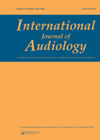
Journal Reviews archive for 2022
How common are swallowing problems in a general adult population?
This paper reports on the largest cross-continent study to date, looking at the prevalence of swallowing problems reported by adults in the community aged 18-65 years old. The authors used the Eating Assessment Tool (EAT-10) distributed via an online survey...
Algorithms to diagnose NIHL
Finding an efficient diagnostic tool for noise-induced hearing loss (NIHL) has been of research interest for a long time. There are several algorithms that compare expected age-related deterioration of hearing with the actual audiogram. This study aimed to compare a...
The basis of auditory processing disorder: what can we learn from corticals?
Auditory processing disorder (APD) is a poorly understood, heterogenous and surprisingly common condition. It manifests as a perceptual difficulty in centrally processing auditory information. Diagnosis is usually based on a variety of behavioural tests involving verbal and non-verbal assessments. In...
Is it really working? Assessment versus real-life language measures
Research in the field of language treatment and rehabilitation to date has used single-word naming as a controlled measure of outcome. Yet, given people do not actually communicate in single words, there is much debate as to whether this approach...
Cochlear implantation following radiotherapy treatment of vestibular schwannomas
The authors presented a case report and systematic review assessing the outcomes of patients from cochlear implantation (CI) following radiotherapy treatment for vestibular schwannoma (VS). Outcomes of cochlear implantation in these patients are uncertain due to the combination of both...
Ultrasound-guided core biopsy of neck lumps as first-line investigative modality supersedes fine needle aspiration cytology in the diagnosis of neck lumps
Ultrasound-guided fine needle aspiration cytology (USFNAC) when applied as initial investigation often proves non-diagnostic, the incidence being as high as 50% in a recent audit. In this study, the authors applied ultrasound-guided core biopsy (USCB) to neck lumps over 1cm...
Assessment of temporal bone skills on 3D-printed temporal bones – a useful training curriculum?
The authors contend it is now archaic to follow Halstead’s model of surgical training, namely ‘see one, do one and teach one’. Simulated training is now widely used in many surgical specialities. With every surgical trainee having an individual learning...
Olfactory and gustatory recovery in coronavirus patients after six months
It remains unclear for how long olfactory and gustatory losses persevere in patients with COVID-19. This is a prospective study of 300 patients who lost taste and smell within seven days of contracting COVID-19. The patients were objectively assessed with...
Effect of COVID-19 on hearing and balance
Rhinological symptoms are cardinal features of COVID-19. However there have only been anecdotal reports on the involvement of the ear, the closest neighbour to the nose and throat. The aim of this study was ‘to assess the presence of persistent...
Are there any benefits of postoperative antibiotics after endoscopic transsphenoidal surgery for pituitary tumours?
This prospective randomised double-blind multicentre study evaluated whether postoperative antibiotics resulted in improvement in sinonasal quality of life (QoL) compared to placebo in patients undergoing endoscopic endonasal transsphenoidal pituitary surgery. A total of 461 patients were screened for the study...
Endovascular therapies for venous tinnitus
Tinnitus is an extremely vexing issue, not only for patients but also for otolaryngologists. The authors of this article review the causes of venous tinnitus, such as increased intracranial hypertension (IIH), dural venous sinus thrombosis and age-related anatomic variants. They...
Reduction in recurrent cholesteatoma rates with bony obliteration tympanoplasty technique
This large retrospective study from the Erasmus Medical Centre in Rotterdam compares outcomes in traditional canal wall up (CWU) and canal wall down (CWD +/- partial obliteration of mastoid bowl) mastoid surgery for cholesteatoma with bony obliteration tympanoplasty (BOT, which...














